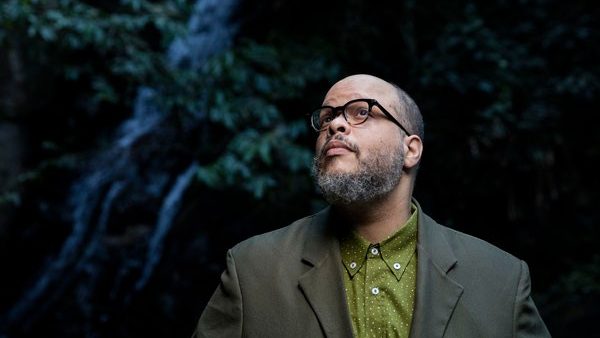Ed, after making a detour into more jazzy territories with “Perpetual Gateways”, it seems that your return with “Criterion Of The Senses” to the West Coast oriented sound of “AOR”. Is that correct?
Yes, it’s more AOR, soul for sure but with also a jazz editorial because of the importance of the solos. Solos are a very important side of the album’s speech.
You’ve described your new album as a “Pop manifesto about using guitars again”. What role do guitar sounds play on this album?
Guitar has lost a bit of that 70’s aura for the new generation. I grew up listening to blues-rock guitarists like Johnny Winter, Rory Gallagher, Jeff Beck and hours of Led Zeppelin. Guitar solos were sacred to me and I used to memorize all of them.
Electric guitar plays a very important role on this album, from chords opening the piano harmonies to solos with different approaches.
I’ve read once that you like it when your audience is seated, now you animate it with the straight 80’s-inflected disco funk of “Your Satisfaction Is Mine” again to stand up and dance. Do you want to return musically to the dance floor?
Since my first album in 1988 soul and funk are my comfort zone, the place where I started making music professionally. I always listen to this music in my house, but no dancing at all (lol).
Ed, in “Shoulder Pads” you pay obvious homage to the Eighties, the time of Walkman, VCRs and shoulder-padded jackets. What fascinates you so much about this epoch?
To be honest, I am more fascinated by the 50s, 60s and 70s, but in the 80s I was an adolescent. I’m very nostalgic and I miss some sensations from that period. When I started to search for AOR records deeply, the 80s became something even more close to me. Even though there’s something ironic on “Shoulder Pads”.
The artwork of “Criterion Of The Senses” is based on a series of oil paintings by Edna Lopes. What do you want to say with the picture language? Should it be a small tribute to Steely Dan’s “Katy Lied”?
Graphic novel artist Edna Lopes, who made lots of my artwork since 1992, was doing a series of oil paintings with insects. I saw them and asked her to do something for me. It’s definitely related to French comic books (bande dessinée is a better terminology). But as an information addict about pop culture, I can remember “Metamorphosis” of The Rolling Stones or that photo of Steely Dan’s masterpiece “Katy Lied”.
After recording “Perpetual Gateways” in LA and working with many well-known American studio musicians, such as Patrice Rushen, you have now recorded again in Brazil. Did it draw you back home?
In fact, recording in the USA was an exception and it was a great experience. Some of my heroes have played there, that was special. To work in Brazil is easier. I have a small studio in my house, so I have more time to do things, unlimited hours to reach a point. Since the 60’s Brazil has – together with the US – the best studio musicians. This is crucial to my music.
Ed, again and again your music is compared to Steely Dan. I know that you are a huge Steely Dan fan. Do such comparisons flatter you or do they increase the pressure when you start to work on a new album?
For me is great and very natural. I use to hear Charles Mingus’ obsession about Duke Ellington through his own art, it’s another angle of that aesthetic. Steely Dan taught me many things and it is there in my music. They are my lucky charm.
How is your relationship to musical perfection?
I’m an obsessive personality. Perfection is something I’m looking for in everything – from a bottle of wine or the way a vegetable was cooked. Of course paranoia is a bonus track on this search for perfection.
Your new album will be released 30 years after your debut “Ed Motta e Conexão Japeri”. How would you retrospectively describe your development as an artist?
In those 30 years I went into several different areas. I made soundtracks, wrote a musical inside Broadway idiom, recorded three jazz tinged albums and had some more adventures like my album “Chapter 9”, where I play all the instruments, all organic, nothing electronic, no loops, nothing, just the real thing.
You are tireless on the road on behalf of your music. Every year you play countless concerts – whether in South America or Europe. From October on you will tour again in Switzerland, Austria and Germany. Would you describe the stage or rather the studio as your natural refuge? And why?
Playing live is pure adventure, maybe the only adrenalin I like. It’s also an opportunity to see many cultures around the world, starting with Brazil, which is a huge country. If you travel from the deep south to the north it could be a six to seven hours flight, it’s like a Rio/Miami flight. The studio is a more creative place for me, more organized, more control, more close to perfection.
You’re known worldwide as a passionate record collector. Your legendary collection comprises over 30,000 albums – and it is constantly growing. How do you get your music? Do you order most of the albums on the internet, or is it possible to meet you in record stores worldwide?
I use to do both, online and record stores. In the ‘90s I was buying pretty much more quantity. Nowadays there are things here and there that I’m still looking for like “Shade of Blue” by the Don Rendell Ian Carr Quintet at a decent price.
Besides your love for music you are also a passionate film fan. How far, do you think, does your music have cinematic qualities? Do you sometimes imagine when writing your songs whether they could also work in movies?
I use to write about classic movies for some magazines, newspapers and DVD liner notes of Brazilian DVD prints of Otto Preminger and Stanley Donen movies. “Criterion Of The Senses” is very cinema influenced. The lyrics on “The Tiki’s Broken There” are very film-noir inspired, and the conspiracy on “X1 In Test” and “Novice Never Noticed” too.
You’ve said once, that writing songs is your mission, your special daily oxygen. What’s next for Ed Motta?
I would like to produce other artists, because the studio is my biggest love in music. Ok, let’s be honest, vinyl comes first (lol).
Photo: F-Cat Productions GmbH
This interview was first published on September 21, 2018.

